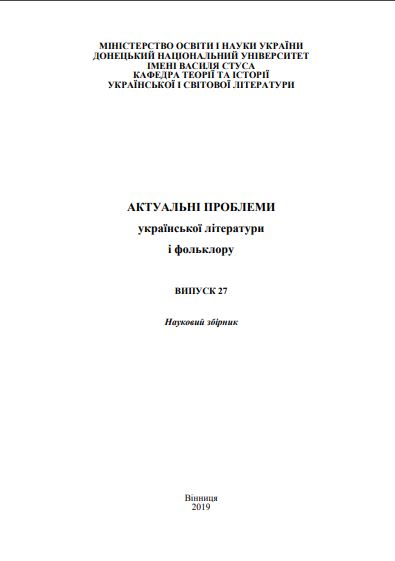Author’s point of view on the rivalry «soviets – UPA – The Home Army– nazi Germany» in A. Kokotiukha’s historical-adventure novel «The Black Forest».
DOI:
https://doi.org/10.31558/2308-1902.2019.27.5Keywords:
novel, opposition, detailed portraiture, four-way confrontation, author’s point of view, A. KokotiukhaAbstract
The following article depicts the research on displays of the author’s point of view on the rivalry «soviets – UPA – The Home Army – nazi Germany» in A. Kokotiukha’s historicaladventure novel «The Black Forest». The emphasis is put on the ideological point of view. It demonstrates, that the author’s point of view is seen through the parallel description of destinies of different characters, through the indirect estimation of the specific situation by the characters, through author’s descriptions-clarifications of the political state, through the opposition «friend of foe», through dialogues of characters about the history and through the detailed portraiture. Comparing to the previous work about UPA, the writer completely changes author’s «tactics and strategy» in evaluating characters and and situations. He gives detailed characteristics of all the present characters immediately without using «intermediary agents» (a journalist, an (special services agent), a tankman, a policeman), performs the role of a narrator. In the novel «The Black Forest» A. Kokotiukha reconstitutes the real situation of the World War II times, when each of the opposing sides had their own «friends»: polish underground worker worked for Germany, while cooperating with soviet troops, UPA also had ones who served both germans and soviets. Compositionally the novel is divided into four parts with expressive headings («Saboteur», «Friends», «Wanda», «Cloud»), that are then divided into smaller ones with headings, that give the precise information about dates and places of events. Respectively, the novel itself has the subheading «Ukrainian Chronicles of 1943». In our society people still percept the history as it is presented by the Russian-soviet context. The author determines the genre of the work as artistic, action-packed historical-adventure novel, but he managed to uncover several historical moments. The polyphonic work contains different points of view, but the author’s attitude is traced from the description of events of prewar reality to the four-way confrontation on the territory of Volyn.References
Бахтин М. М. Автор и герой в эстетической деятельности / Эстетика словесного творчества / Михаил Михайлович Бахтин; [сост. С. Г. Бочаров; текст подготовит. Г. С. Бернштейн и Л. В. Дерюгина; примеч. С. С. Аверинцева и С. Г. Бочарова]. [2-е изд.]. Москва: Искусство, 1979. С. 7–181.
Галич О., Назарець В., Васильєв Є. Теорія літератури. Київ: Либідь. 2001. 486 с.
Ільюшин І. Українська повстанська армія і Армія Крайова. Протистояння в Західній Україні (1939–1945 рр.). Київ : Вид. дім «Києво-Могилянська академія», 2009. 399 с.
Кокотюха А. Від автора / Кокотюха А. Чорний ліс: роман / Харків: Книжковий клуб «Клуб Сімейного Дозвілля», 2015. С. 296–299.
КокотюхаА.Чорнийліс. Харків : КнижковийКлуб «КлубСімейногоДозвілля», 2015. 304 с.
Поэтика : Словарь актуальных терминов и понятий : [гл. науч. ред. Н.Д. Тамарченко]. Москва : Издательство Кулагиной, Intrada. 2008. 358 с.
Субтельний О. Історія України. Київ : Либідь. 1993. 718 с.
Успенский Б.А. Поэтика композиции. Москва : СПб: Азбука. 2000. 352 с.
Патриляк І. За лаштунками партизанської війни / Кокотюха А. Чорний ліс: роман / Харків: Книжковий Клуб «Клуб Сімейного Дозвілля», 2015. С. 5–6.

